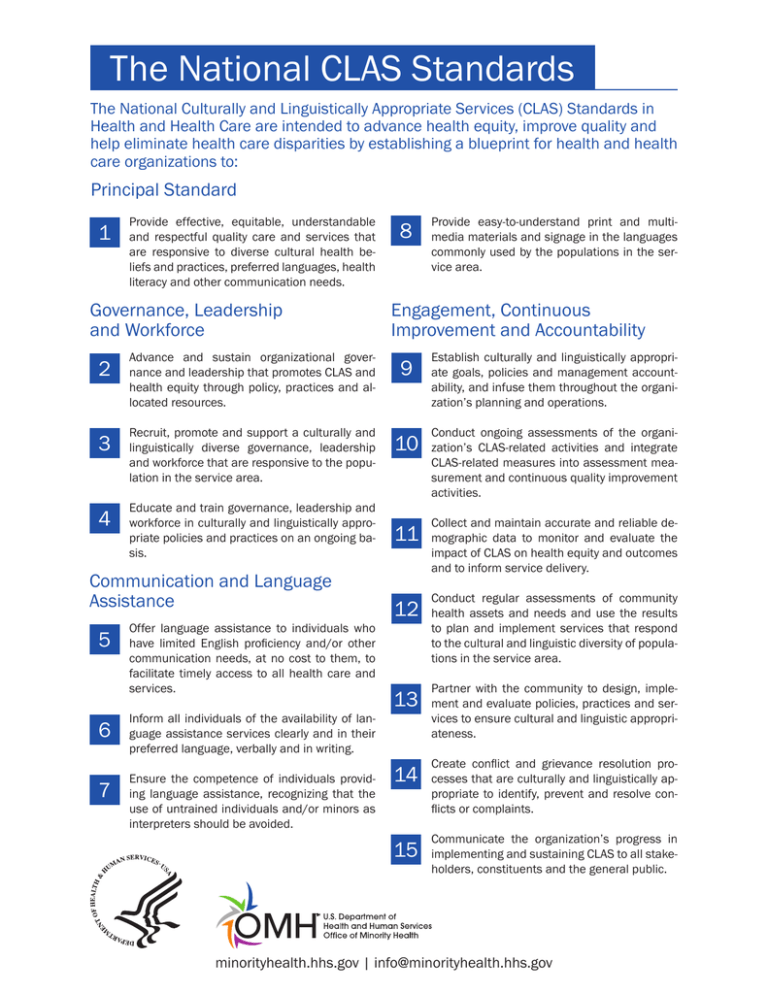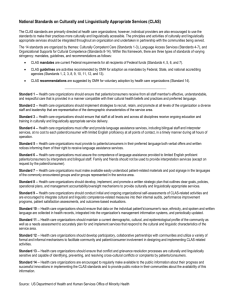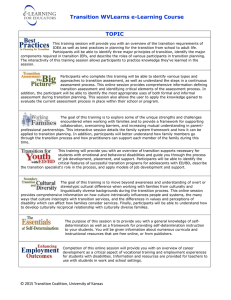The National CLAS Standards
advertisement

The National CLAS Standards The National Culturally and Linguistically Appropriate Services (CLAS) Standards in Health and Health Care are intended to advance health equity, improve quality and help eliminate health care disparities by establishing a blueprint for health and health care organizations to: Principal Standard 1 Provide effective, equitable, understandable and respectful quality care and services that are responsive to diverse cultural health beliefs and practices, preferred languages, health literacy and other communication needs. Governance, Leadership and Workforce 8 Provide easy-to-understand print and multimedia materials and signage in the languages commonly used by the populations in the service area. Engagement, Continuous Improvement and Accountability 2 Advance and sustain organizational governance and leadership that promotes CLAS and health equity through policy, practices and allocated resources. 9 Establish culturally and linguistically appropriate goals, policies and management accountability, and infuse them throughout the organization’s planning and operations. 3 Recruit, promote and support a culturally and linguistically diverse governance, leadership and workforce that are responsive to the population in the service area. 10 4 Educate and train governance, leadership and workforce in culturally and linguistically appropriate policies and practices on an ongoing basis. Conduct ongoing assessments of the organization’s CLAS-related activities and integrate CLAS-related measures into assessment measurement and continuous quality improvement activities. 11 Collect and maintain accurate and reliable demographic data to monitor and evaluate the impact of CLAS on health equity and outcomes and to inform service delivery. 12 Conduct regular assessments of community health assets and needs and use the results to plan and implement services that respond to the cultural and linguistic diversity of populations in the service area. 13 Partner with the community to design, implement and evaluate policies, practices and services to ensure cultural and linguistic appropriateness. 14 Create conflict and grievance resolution processes that are culturally and linguistically appropriate to identify, prevent and resolve conflicts or complaints. 15 Communicate the organization’s progress in implementing and sustaining CLAS to all stakeholders, constituents and the general public. Communication and Language Assistance 5 Offer language assistance to individuals who have limited English proficiency and/or other communication needs, at no cost to them, to facilitate timely access to all health care and services. 6 Inform all individuals of the availability of language assistance services clearly and in their preferred language, verbally and in writing. 7 Ensure the competence of individuals providing language assistance, recognizing that the use of untrained individuals and/or minors as interpreters should be avoided. minorityhealth.hhs.gov | info@minorityhealth.hhs.gov The Case for Enhanced National CLAS Standards Of all the forms of inequality, injustice in health care is the most shocking and inhumane. — Dr. Martin Luther King, Jr. Health equity is the attainment of the highest level of health for all people. Currently, individuals across the United States from various cultural backgrounds are unable to attain their highest level of health for several reasons, including the social determinants of health, or those conditions in which individuals are born, grow, live, work and age1, such as socioeconomic status, education level and the availability of health services2. Though health inequities are directly related to the existence of historical and current discrimination and social injustice, one of the most modifiable factors is the lack of culturally and linguistically appropriate services, broadly defined as care and services that are respectful of and responsive to the cultural and linguistic needs of all individuals. Health inequities result in disparities that directly affect the quality of life for all individuals. Health disparities adversely affect neighborhoods, communities and the broader society, thus making the issue not only an individual concern but also a public health concern. In the United States, it has been estimated that the combined cost of health disparities and subsequent deaths due to inadequate and/or inequitable care is References: 1. World Health Organization. (2012). Social determinants of health. Retrieved from http://www.who.int/social_ determinants/en/ 2. U.S. Department of Health and Human Services, Office of Disease Prevention and Health Promotion. (2010). Healthy people 2020: Social determinants of health. Retrieved from http://www.healthypeople.gov/2020/topicsobjectives2020/ overview.aspx?topicid=39 3. LaVeist, T. A., Gaskin, D. J., & Richard, P. (2009). The economic burden of health inequalities in the United States. Retrieved from the Joint Center for Political and Economic Studies website: http://www.jointcenter.org/sites/default/ files/upload/research/files/The%20Economic%20Burden%20 of%20Health%20Inequalities%20in%20the%20United%20 States.pdf 4. Beach, M. C., Cooper, L. A., Robinson, K. A., Price, E. G., Gary, T. L., Jenckes, M. W. Powe, N.R. (2004). Strategies for $1.24 trillion3. Culturally and linguistically appropriate services are increasingly recognized as effective in improving the quality of care and services4, 5. By providing a structure to implement culturally and linguistically appropriate services, the enhanced National CLAS Standards will improve an organization’s ability to address health care disparities. The enhanced National CLAS Standards align with the HHS Action Plan to Reduce Racial and Ethnic Health Disparities6 and the National Stakeholder Strategy for Achieving Health Equity7. Both documents aim to promote health equity by providing clear plans and strategies to guide collaborative efforts that address racial and ethnic health disparities across the country. Similar to these initiatives, the enhanced National CLAS Standards are intended to advance health equity, improve quality and help eliminate health care disparities by providing a blueprint for individuals and health and health care organizations to implement culturally and linguistically appropriate services. Adoption of these Standards will help advance better health and health care in the United States. improving minority healthcare quality. (AHRQ Publication No. 04-E008-02). Retrieved from the Agency of Healthcare Research and Quality website: http://www.ahrq.gov/ downloads/pub/evidence/pdf/minqual/minqual.pdf 5. Goode, T. D., Dunne, M. C., & Bronheim, S. M. (2006). The evidence base for cultural and linguistic competency in health care. (Commonwealth Fund Publication No. 962). Retrieved from The Commonwealth Fund website: http://www.commonwealthfund.org/usr_doc/Goode_ evidencebasecultlinguisticcomp_962.pdf 6. U.S. Department of Health and Human Services. (2011). HHS action plan to reduce racial and ethnic health disparities: A nation free of disparities in health and health care. Retrieved from http://minorityhealth.hhs.gov/npa/ files/Plans/HHS/HHS_Plan_complete.pdf 7. U.S. Department of Health and Human Services, Office of Minority Health (2011). National Partnership for Action to End Health Disparities. Retrieved from http:// minorityhealth.hhs.gov/npa April 2013 minorityhealth.hhs.gov | info@minorityhealth.hhs.gov

